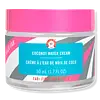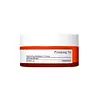What's inside
What's inside
 Key Ingredients
Key Ingredients

 Benefits
Benefits

 Concerns
Concerns

 Ingredients Side-by-side
Ingredients Side-by-side

Cocos Nucifera Fruit Juice
EmollientGlucose
HumectantMaltodextrin
AbsorbentWater
Skin ConditioningDimethicone
EmollientSodium Acrylate/Sodium Acryloyldimethyl Taurate Copolymer
Emulsion StabilisingCocos Nucifera Fruit Extract
EmollientSodium Hyaluronate
HumectantAlteromonas Ferment Filtrate
HumectantPyrus Malus Fruit Extract
Skin ConditioningPrunus Armeniaca Fruit Extract
Skin ConditioningVanilla Planifolia Fruit Extract
Skin ConditioningSea Salt
AbrasiveLycium Barbarum Fruit Extract
AstringentGlycyrrhiza Glabra Root Extract
BleachingChrysanthemum Parthenium Extract
Skin ConditioningCamellia Sinensis Leaf Extract
AntimicrobialDipteryx Odorata Seed Extract
MaskingCoffea Arabica Seed Extract
MaskingTocopherol
AntioxidantCaprylyl Glycol
EmollientCaprylic/Capric Triglyceride
MaskingButylene Glycol
HumectantHydrogenated Polydecene
EmollientDipropylene Glycol
HumectantCetyl Diglyceryl Tris(Trimethylsiloxy)Silylethyl Dimethicone
Emulsion StabilisingPolysilicone-11
Laureth-8
EmulsifyingPhenoxyethanol
PreservativeCocos Nucifera Fruit Juice, Glucose, Maltodextrin, Water, Dimethicone, Sodium Acrylate/Sodium Acryloyldimethyl Taurate Copolymer, Cocos Nucifera Fruit Extract, Sodium Hyaluronate, Alteromonas Ferment Filtrate, Pyrus Malus Fruit Extract, Prunus Armeniaca Fruit Extract, Vanilla Planifolia Fruit Extract, Sea Salt, Lycium Barbarum Fruit Extract, Glycyrrhiza Glabra Root Extract, Chrysanthemum Parthenium Extract, Camellia Sinensis Leaf Extract, Dipteryx Odorata Seed Extract, Coffea Arabica Seed Extract, Tocopherol, Caprylyl Glycol, Caprylic/Capric Triglyceride, Butylene Glycol, Hydrogenated Polydecene, Dipropylene Glycol, Cetyl Diglyceryl Tris(Trimethylsiloxy)Silylethyl Dimethicone, Polysilicone-11, Laureth-8, Phenoxyethanol
Water
Skin ConditioningDipropylene Glycol
HumectantCaprylic/Capric Triglyceride
MaskingGlycerin
HumectantHydrogenated Poly(C6-14 Olefin)
Emollient1,2-Hexanediol
Skin ConditioningNiacinamide
SmoothingGlyceryl Stearate Se
EmulsifyingVinyldimethicone
Polyglyceryl-3 Distearate
EmulsifyingStearic Acid
CleansingCetearyl Alcohol
EmollientAmmonium Acryloyldimethyltaurate/Vp Copolymer
Carbomer
Emulsion StabilisingTromethamine
BufferingCetyl Ethylhexanoate
EmollientGlyceryl Stearate Citrate
EmollientEthylhexyl Palmitate
EmollientCetearyl Glucoside
EmulsifyingHydrogenated Lecithin
EmulsifyingTocopherol
AntioxidantSodium Methyl Stearoyl Taurate
CleansingAdenosine
Skin ConditioningEthylhexylglycerin
Skin ConditioningDisodium EDTA
Panthenol
Skin ConditioningPearl Extract
AntioxidantButylene Glycol
HumectantArachidic Acid
CleansingPalmitic Acid
EmollientMacadamia Ternifolia Seed Oil
EmollientGlucose
HumectantOleic Acid
EmollientBrassica Campestris Sterols
EmollientCholesterol
EmollientPhytosteryl/Behenyl/Octyldodecyl Lauroyl Glutamate
Skin ConditioningSodium Hyaluronate
HumectantPolyglyceryl-10 Oleate
Skin ConditioningCaprylyl Glycol
EmollientCeramide NP
Skin ConditioningPotassium Cetyl Phosphate
EmulsifyingChrysanthemum Morifolium Flower Extract
Skin ConditioningBroussonetia Kazinoki Root Extract
Skin ConditioningHyaluronic Acid
HumectantAscorbic Acid
AntioxidantCeramide Ns
Skin ConditioningCeramide EOP
Skin ConditioningWater, Dipropylene Glycol, Caprylic/Capric Triglyceride, Glycerin, Hydrogenated Poly(C6-14 Olefin), 1,2-Hexanediol, Niacinamide, Glyceryl Stearate Se, Vinyldimethicone, Polyglyceryl-3 Distearate, Stearic Acid, Cetearyl Alcohol, Ammonium Acryloyldimethyltaurate/Vp Copolymer, Carbomer, Tromethamine, Cetyl Ethylhexanoate, Glyceryl Stearate Citrate, Ethylhexyl Palmitate, Cetearyl Glucoside, Hydrogenated Lecithin, Tocopherol, Sodium Methyl Stearoyl Taurate, Adenosine, Ethylhexylglycerin, Disodium EDTA, Panthenol, Pearl Extract, Butylene Glycol, Arachidic Acid, Palmitic Acid, Macadamia Ternifolia Seed Oil, Glucose, Oleic Acid, Brassica Campestris Sterols, Cholesterol, Phytosteryl/Behenyl/Octyldodecyl Lauroyl Glutamate, Sodium Hyaluronate, Polyglyceryl-10 Oleate, Caprylyl Glycol, Ceramide NP, Potassium Cetyl Phosphate, Chrysanthemum Morifolium Flower Extract, Broussonetia Kazinoki Root Extract, Hyaluronic Acid, Ascorbic Acid, Ceramide Ns, Ceramide EOP
 Reviews
Reviews

Ingredients Explained
These ingredients are found in both products.
Ingredients higher up in an ingredient list are typically present in a larger amount.
Butylene Glycol (or BG) is used within cosmetic products for a few different reasons:
Overall, Butylene Glycol is a safe and well-rounded ingredient that works well with other ingredients.
Though this ingredient works well with most skin types, some people with sensitive skin may experience a reaction such as allergic rashes, closed comedones, or itchiness.
Learn more about Butylene GlycolThis ingredient is an emollient, solvent, and texture enhancer. It is considered a skin-softener by helping the skin prevent moisture loss.
It helps thicken a product's formula and makes it easier to spread by dissolving clumping compounds.
Caprylic Triglyceride is made by combining glycerin with coconut oil, forming a clear liquid.
While there is an assumption Caprylic Triglyceride can clog pores due to it being derived from coconut oil, there is no research supporting this.
Learn more about Caprylic/Capric TriglycerideCaprylyl Glycol is a humectant and emollient, meaning it attracts and preserves moisture.
It is a common ingredient in many products, especially those designed to hydrate skin. The primary benefits are retaining moisture, skin softening, and promoting a healthy skin barrier.
Though Caprylyl Glycol is an alcohol derived from fatty acids, it is not the kind that can dry out skin.
This ingredient is also used as a preservative to extend the life of products. It has slight antimicrobial properties.
Learn more about Caprylyl GlycolDipropylene Glycol is a synthetically created humectant, stabilizer, and solvent.
This ingredient helps:
Dipropylene glycol is technically an alcohol, but it belongs to the glycol family (often considered part of the ‘good’ alcohols). This means it is hydrating and gentle on skin unlike drying solvent alcohols like denatured alcohol.
As a masking agent, Dipropylene Glycol can be used to cover the smell of other ingredients. However, it does not have a scent.
Studies show Dipropylene Glycol is considered safe to use in skincare.
Learn more about Dipropylene GlycolGlucose is a simple sugar and is the most important source of energy in all organisms.
In skincare, glucose is used to hydrate the skin. It also acts as a prebiotic for our natural biome.
Glucose is hydrating due to its humectant property. As a humectant, glucose draws moisture from the air and from deeper levels in the skin.
Our skin contains many sugars that act as prebiotics and help strengthen our natural microbiome. Having a healthy microbiome helps protect our skin from harmful bacteria and other contaminants.
Studies show glucose may help with fading discoloration and pigmentation. This is because our skin metabolizes glucose into lactic acid. Lactic acid is an AHA that helps exfoliate the top layer of skin.
Learn more about GlucoseSodium Hyaluronate is hyaluronic acid's salt form. It is commonly derived from the sodium salt of hyaluronic acid.
Like hyaluronic acid, it is great at holding water and acts as a humectant. This makes it a great skin hydrating ingredient.
Sodium Hyaluronate is naturally occurring in our bodies and is mostly found in eye fluid and joints.
These are some other common types of Hyaluronic Acid:
Learn more about Sodium HyaluronateTocopherol (also known as Vitamin E) is a common antioxidant used to help protect the skin from free-radicals and strengthen the skin barrier. It's also fat soluble - this means our skin is great at absorbing it.
Vitamin E also helps keep your natural skin lipids healthy. Your lipid skin barrier naturally consists of lipids, ceramides, and fatty acids. Vitamin E offers extra protection for your skin’s lipid barrier, keeping your skin healthy and nourished.
Another benefit is a bit of UV protection. Vitamin E helps reduce the damage caused by UVB rays. (It should not replace your sunscreen). Combining it with Vitamin C can decrease sunburned cells and hyperpigmentation after UV exposure.
You might have noticed Vitamin E + C often paired together. This is because it is great at stabilizing Vitamin C. Using the two together helps increase the effectiveness of both ingredients.
There are often claims that Vitamin E can reduce/prevent scarring, but these claims haven't been confirmed by scientific research.
Learn more about TocopherolWater. It's the most common cosmetic ingredient of all. You'll usually see it at the top of ingredient lists, meaning that it makes up the largest part of the product.
So why is it so popular? Water most often acts as a solvent - this means that it helps dissolve other ingredients into the formulation.
You'll also recognize water as that liquid we all need to stay alive. If you see this, drink a glass of water. Stay hydrated!
Learn more about Water